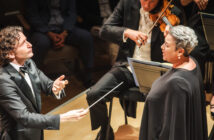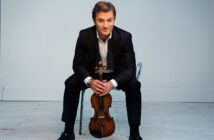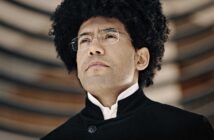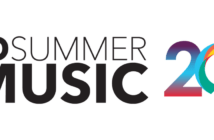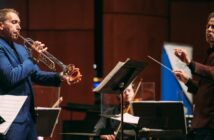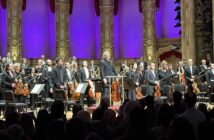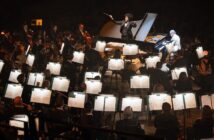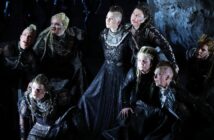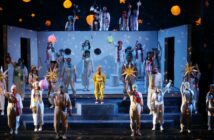by Paul E. Robinson
CLASSICAL TRAVELS
River Cruise along the Main, the Rhine and the Danube
August 2013
This past August, Marita and I thoroughly enjoyed the “European Jewels” Uniworld River Cruise from Amsterdam to Budapest. We were not expecting a concentration of musical events on this excursion; rather, we thought it would give us a view of Europe from a new perspective (i.e., docking within walking distance of towns and cities) – and it did, but to our delight, there was glorious music on this cruise as well, often in unexpected places.
Up until about 20 years ago, this particular river cruise would not even have been possible; there simply was no water route connecting Holland, Germany, Austria and Hungary. The Romans had a dream to connect the Rhine and the Danube, to have a water route from the Black Sea to the North Sea (2,170 miles), a dream realized only in the 20th century.
The challenge was the Main River – full of rapids and swamps – between the Rhine and the Danube. Charlemagne tried unsuccessfully to make a canal in 793; what remains of his efforts is known as Charlemagne’s Ditch. King Ludwig tried again in 1837, and completed a canal with no fewer than 101 locks, which opened in 1843. Parts of it still exist. Unfortunately, it was opened at a time when the railways were getting established and railways proved to be faster and more economical; hence, Ludwig’s canal was abandoned….until the 1970s.
The 106 mile long Main-Danube Canal, on the current route of our Uniworld European Jewels (Amsterdam to Budapest) river cruise, dreamt about and even attempted by the Romans, was fully open only in 1992.
In modern times, the first section – from Bamberg to Nuremberg (44 miles) – was finished in 1976 with 7 locks. Continuation was opposed by the Green Party and changes were made to the design to make it less straight, more interesting and with more recreational aspects. The whole Main-Danube canal cost US$4.2 billion to build. Most of the locks are combined with hydro-electric power plants. The great advantages of the canal are 1) cheaper transportation, especially of bulk cargos, and 2) flood control. The maximum lock width is 39 ft (our ship was 37 ft). Water to operate the locks comes from reservoirs (60%) and from the canal itself (40%). The Continental Divide is in the middle of the canal.
Nightwatch in Amsterdam
We began our cruise in Amsterdam, and at the top of my agenda was a visit to the newly renovated Rijksmuseum. It seems everybody else had the same idea; the place was packed. We did manage to make our way to the pièce de resistance, Rembrandt’s Nightwatch (full and formal title: The Shooting Company of Frans Banning Cocq) and we were suitably awed by the sight of this famous masterpiece.
What we hadn’t realized until our visit to the museum, was that the subject matter of Remb
randt’s Nightwatch (i.e., a group portrait of a militia), had been rendered by no fewer than six other artists in Amsterdam in Rembrandt’s time (1642). The curators of the Rijksmuseum made us aware of this fact by surrounding Nightwatch with the six other paintings depicting the same subject – if not the same militia. What makes Nightwatch stand out from these others, we saw, was not the subject matter, but Rembrandt’s distinctive artistry – his eye for detail and differentiation, the command of light and shade (chiaroscuro)
In spite of being in “awe” of this masterpiece, however, I must admit I was somewhat disappointed to see Nightwatch “in the flesh”, as it were. The painting seemed less dramatic than I had expected, and less mysterious. Several years ago new LED lights were installed in the Nightwatch room at the Rijksmuseum to save energy and reduce the harm which might be done to the paintings by UV radiation. It may be that the new museum lighting is too “white” for the painting. More likely, it is the fact that the Nightwatch we see in books is the painting as it looked before 1940. “Nightwatch” is, after all, only a nickname and a misconceived one at that. Under the dark varnish people thought this was a night scene, but “after layers of varnish and dirt were stripped away in the 1940s”, it turns out that the painting has nothing to do with night.
A Taste of Brahms in Rüdesheim
We set off down the Rhine with stops at Cologne and Rüdesheim. Rüdesheim is a charming old town, well-known today for its Rüdesheimer Kaffee, a concoction laced with local liquor and topped with whipped cream. The town is also famous for its vineyards and for its monument to German unity high on a hill. We took a cable car up the hill then walked back down through the vineyards. But while we were strolling through the park at the top we noticed a sign which said “Brahms Weg” or “Brahms Way.” It seems that Brahms had friends in Rüdesheim and when he visited he loved to walk through the woods leading to the monument. The view is spectacular and one can imagine Brahms enjoying nature and pondering Germany’s role in the world as he walked.
Street Music in Würzburg
Würzburg is the largest city in Franconia and dates its history back to 1000 BC when Celtic tribes settled here. Our guides stressed that while Würzburg is in the state of Bavaria, its residents do not like to be called Bavarians. They consider themselves Franconians. In 1945, just before the end of the war, the city of Würzburg was 87% destroyed by Allied bombing; over 4,000 people were killed.
The Würzburg Residenz is one of the architectural glories of the Baroque in Austria. It was designed by the architect Balthasar Neumann with ceiling frescoes by Tintoretto. Our guide stressed how unique it was to have such a huge unsupported ceiling over the entrance staircase, with an enormously detailed fresco above. It was all very impressive in the Versailles manner with long ornate corridors and rooms, and vast, elaborate gardens in the surrounding area.
Later, we went into the wine cellar of the Residenz for some wine-tasting; all local, and somewhat sweet white wines.
After the tour, during the hour or so we had to ourselves in Würzburg, we strolled around the downtown area, taking in the sights: a large cathedral (Dom), a castle high on the high bank at the other side of the river, and the Alte Main Brücke, a narrow pedestrian bridge lined with statues of historic figures and small wine bars, each with a few outside tables on the bridge – a great “people” place, especially on this bright, warm (81F) day. This bridge, destroyed by Allied planes near the end of the war, has been fully rebuilt. While walking through downtown we came across a street performance by a four-man vocal group from Minsk – very good, singing mostly Russian folk songs. They collected some money from listeners on the street and hopefully sold some of their CDs.
Schumann’s Stint in Heidelberg
Heidelberg is best known for Heidelberger Schloss, high on a hill overlooking the city. Work on the castle began in 1214 and continued for hundreds of years. Throughout its history, this castle was frequently attacked and much of it destroyed. In the Nineteenth Century
it became more famous than ever as a ruin. Victor Hugo wrote eloquently about it and so too did Mark Twain. Turner painted the ruined Powder Tower into legend. The romantics could see in Heidelberg Castle the story of man himself struggling to create something enduring only to be foiled and defeated, with nature swallowing up what is left. It was a castle of hopes and dreams, and disappointments.
I hadn’t been aware of any musical connections in Heidelberg, but on the main street there was a plaque high on the wall of a house, noting that Schumann had lived there as a student in the years 1829/30.
Passau’s Massive Pipe Organ!
There are no fewer than 168 locks on our sojourn from Amsterdam to Budapest. Not surprisingly, we were frequently being lifted up or dropped down, and occasionally waiting for other boats to clear the narrow locks. There was some congestion at the big lock just before Passau, and so we arrived late. We still got there in time for a walking tour through this charming town, however, and concluded our visit with an organ recital in Dom St. Stephan.
In almost every town on our journey we were reminded how fickle and threatening Nature can be. Flooding is an almost annual event, and last year’s flooding in Passau was undoubtedly some of the worst ever; we saw buildings with marks on the wall indicating the high water levels year by year. Local citizens have been making these marks for centuries, and last year’s marks were the highest.
The Dom St. Stephan (St. Stephen’s Cathedral), originally a Gothic church, with all the austerity and gloominess that term implies, was expanded significantly in the 17th century during the Baroque era. It is a huge building with stucco decoration, a gold, carved wood pulpit and elaborate painted walls and ceilings. Restoration has been going on for years and is nearly completed. The outside is a brilliant white color, and the interior has been made to look like new.
The Dom St. Stephan organ is said to be the largest cathedral organ in the world. It was built in 1928 then rebuilt 1978-81. There are 5 separate organs, over 17, 974 pipes and 230 stops. We heard a recital by Michael Kapaner, performing his own improvisation on a “gegebenes Thema.” It produced a huge sound with lots of special tonal and spatial effects. Bach’s Prelude and Fugue in G major BWV 541 was magnificent as well, if rather larger than life. For me the best piece was Liszt’s Prelude and Fugue on B-A-C-H – a great piece, performed with flair, virtuosity and imagination. The Dom St. Stephan organ is most certainly a wonder to hear and behold… not to be confused, in any way, with the baroque organs for which the composer Bach wrote, or even the 19th century organs familiar to Liszt.
Magnificent Melk Abbey
After Passau we sailed to Melk, Austria. It was a beautiful day. We took the tour bus up the hill to tour the abbey, after which we walked down the hill, through the little town, back to the ship.
The sole attraction on this stop was the 900-year old Melk Abbey. Like so many buildings in Germany and Austria, the original edifice is very old, but most of what we see today is from the Baroque era. Melk Abbey has been recently restored with bright yellow colors and a few modern additions. Although impressive, one can’t help but be shocked by the Baroque additions, especially in the church – particularly all the detailed frescoes on the ceilings. One would have to lie down on the floor to really see them without breaking one’s neck. Optical illusions were used in the design of the abbey; for example, both the library and the mirror room have an extra tier painted on the ceiling to create the illusion of greater height.
It was Leopold III in the 11th century who handed over his castle to the Benedictine monks. They converted it into a fortified abbey, and from then on the spiritual and intellectual renown of Melk spread throughout Austria.
One of the glories of Melk Abbey is the library, a gigantic collection of some 80,000 priceless books hundreds of years old. Our guide told us stories about Maria Theresia visiting Melk Abbey with a retinue of 300 people. And rooms were found for all of them!
Back on board the River Empress, and headed for Vienna, we were treated to an Austrian menu of Wiener Schnitzel and sides, A few hours later, we docked on the Danube, several miles from the centre of Vienna.
The Wiener Hofburg-Orchester
After dinner we were taken by bus to the Hofburg Palace in the heart of Vienna for an orchestral concert of music by members of the Strauss family and Mozart. The Hofburg is one of the la
rgest and grandest public buildings in Vienna and is now the official residence of the President of Austria. The concert was given in the Festsaal and it was good fun: lots of comedy in the polkas Vergnügungszug (Pleasure Train) and Feuerfest (Fireproof). The latter features a pair of anvils used as percussion instruments – more or less. The orchestra was the Wiener Hofburg-Orchesterconducted by Kurt Schmid. When we returned to the ship about 10:30 pm a late night Austrian snack awaited us. We had frankfurters and beer.
We took a guided tour of the city in the morning past all the famous sites. We were dropped in front of the Albertina Museum near the Wiener Staatsoper, and had strudel and coffee at Café Mozart. The story goes that Graham Greene spent many hours here while writing the screenplay for The Third Man.From there we walked down the pedestrian mall to St. Stephen’s Cathedral. The city is teeming with tourists and it looks energetic and prosperous. Nearly all the great public buildings have been refurbished, and the shops on Kärtnerstrasse feature all the best-known international names.
Schönbrunn and the Pressburger Duo
In the afternoon we took a guided tour of Schönbrunn Palace, the summer home of the Hapsburgs. “Schonbrunn” means “Beautiful Spring.” It was incredibly crowded there with dozens of tour groups – shoulder to shoulder from room to room. We saw about 20 rooms in this vast palace and our guide was very informative about Maria Theresia, Franz Josef, and all the key historical figures of this period. We noted that there was a well-stocked Chinese room and a lot of chinoiserie elsewhere. Outside the palace there are vast gardens with mazes and architectural structures of various kinds. In recent years the Vienna Philharmonic has given annual concerts in the vast gardens. Christoph Eschenbach will lead this year’s concert in May.
The Third Man was in evidence everywhere in Vienna. Our guides pointed out the ferris wheel in the Prater used for a scene in the film. At one point during our tour we noticed a group of tourists wearing hard hats. They were about to tour the sewers of Vienna. The sewers figure prominently in the climactic chase scene in The Third Man.
The ship sailed from Vienna at sunset and during the evening we passed by the city of Bratislava in Slovakia. When we stopped to transit one of the locks on the Danube we were joined by two musicians known as the Pressburger Duo. “Pressburg” was the old name for Bratislava. On board in the lounge the Pressburger Duo gave one of the most remarkable concerts I have ever seen or heard. The two musicians are Robert Puskar who plays the violin, the pan flute and a host of other folk instruments from the region, and Peter Ninaj, a pianist and accordionist. Both men worked for years at the operetta theatre known as Nova Scena in Bratislava.
Puskar is a virtuoso fiddler of the highest order and tossed off some of the most difficult showpieces in the repertoire as if they were child’s play. Then while the audience was still pulling itself together after this dazzling show, he re-presented himself as an opera singer, and not a bad one either. Finally, he captured the crowd with a succession of performances on various folk instruments starting with the pan flute.
Some older music-lovers may recall how a man named Zamfir popularized this instrument back in the 1970s and then vanished without a trace, taking the pan flute with him. The pan flute remains a beautiful instrument capable of coveying the tenderest feelings, and Puskar proved himself to be a master on this instrument too. This concert was more than music, incorporating a good deal of humour, musical and otherwise. Great stuff for cruise entertainment, with a level of musicianship and imagination that should not be underestimated.
The Vigado, Liszt, and a Gypsy Trio
In Budapest we stayed at the Intercontinental, a short drive along the waterfront from where our ship had docked. It is in a perfect location, on the Danube near the Chain Bridge, looking across at the Statue of Liberty and the Gellert memorial on the hills in Buda. The lighting at night is spectacular.
Both Vienna and Budapest have hundreds of buildings from the Hapsburg era and earlier, but today’s Vienna has managed to move with the times – it’s modern and affluent – while preserving the glorious palaces and public and private buildings from pa
st centuries. In contrast, Budapest, while it has lots to boast about in the way of architectural achievements, where the restoration process has been much slower, has lagged behind the times. Buildings appear freshly cleaned and painted in Vienna; in Budapest they are often blackened (the results of bombings and battle) and depressing. The political recovery too has been much slower in Budapest. One fears for the future with the “far right” again coming to prominence. As a side note: pianist Andras Schiff has declared that he will not return to his homeland while the current regime remains in charge.
I had been in Budapest several times before this visit and had fond memories of conducting in the newly-restored Vigado, a beautiful concert hall where Liszt had played. On this visit I was shocked to see that the Vigado was now shuttered and being allowed to fall apart. It is no longer used for concerts or anything else.
We had breakfast in the hotel. Not very good: cold coffee and disappointing pastries. The next day was a different story. Just around the corner from the hotel was Café Gerbeaud, the most famous coffee house in Budapest. And it lived up to its reputation. We sat outside on the patio facing the bustling square, and enjoyed a piping hot cappuccino and delicious pastries. Café Gerbeaud was built in 1858 of stucco, marble, exotic woods and bronze and it attracted famous clientele for many years. When Budapest fell on hard times during the Nazi and Soviet eras Café Gerbeaud suffered too and became a shadow of its former self. But in 1995 it was fully restored and today looks splendid.
In the afternoon we took a cab to the House of Terror. This is a museum documenting the horrors of both the Nazi and the Soviet occupations of Hungary. In 1944, this very building was the headquarters of the Hungarian Nazis, and between 1945 and 1956 it was the headquarters of the notorious communist terror organizations, the AVO and its successor the AVH. In the words of the museum brochure, “60 AndrássyAvenue has become the house of terror and dread.” In the basement of this building the Hungarian Nazis known as the Arrow Cross Party tortured and killed hundreds of people. It was appalling to see video interviews with people who had been victims and to watch all the mundane details of how it was done.
Andrássy Avenue, on which this museum chronicling the horrors of Hungary’s history is located, is one of the most beautiful streets in Budapest – incongruous, all this loveliness in the same space as the House of terror.
We passed by a monument to Liszt in Liszt Square and stopped for coffee at the beautiful Alexandrabook store. It has its own coffee house and in general it could have been a model for many of the Barnes and Noble stores in the United States, except that the architecture of, and the artwork in this building are far more interesting; the Alexandra is as much an art gallery as a bookstore. While many retailers in Budapest may be struggling to grow their businesses, this store was well-stocked and full of customers.
For dinner we strolled down the waterfront in front of our hotel to a restaurant called Dunacorso, and were seated on the patio. The food was delicious (I had Paprika Veal Stew), and the music – a gypsy trio – was excellent as well. Each of the three players was a virtuoso in his own right: violin (Lajos Padar), cimbalom (Gustav Malacsik), and double bass (Ferenc Rigo). Their program included the music that inspired Brahms to write his Hungarian Dances, as well as popular songs, opera arias, and jazz – all of it performed with passion and superb technique. Instead of tipping them, we bought one of their CDs.
As mentioned earlier, I had visited Budapest, Vienna, and Amsterdam before, but to experience these cities as part of a cruise down the Rhine, the Main and the Danube is something else altogether. The ship (River Empress) is small – only acommodates about 120 passengers – and elegant, with a first-class dining room. The food, in general, was excellent…and with great imagination, the chef planned each day’s menu to relate to the region we were pas
sing through.


